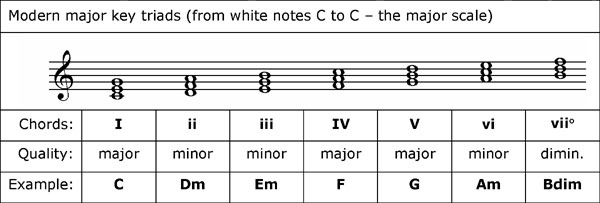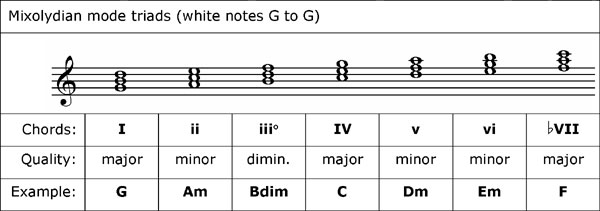Modes - Reference Two
The Modes as Keys
Only four modes offer anything useful in the modern popular music context. They are the Ionian, the Mixolydian, the Dorian and the Aeolian.
The Ionian mode
The Ionian mode survives as our modern major scale and key system, and accounts for the greater part of all the music we hear today. Learning to ‘pull the levers’ of this modern harmonic system should be the first priority of anyone wishing to be a creative modern musician, and teaching this is the aim of the Musicarta Chord Progressions series of lessons. Use the Chords tab in the navbar to access the series overview pages. (You do not need to have completed the Chord Progressions series to study modes.)
The Mixolydian mode
The Mixolydian differs from the modern major scale in having a flattened seventh scale degree. The characteristic sound of the Mixolydian mode is therefore chord ‘ëVII’ – ‘flat seven’, a major chord one whole tone below the tonic (I) chord. One result is the chord sequence ëVII–IV–I – an iconic rock sound and a great jamming sequence explored in Module Two.
The Dorian and Aeolian modes
The Dorian and Aeolian are both minor modes – the third scale degree is flattened.
The distinctive feature of the minor modes is that their all-important dominant chord (built on the fifth degree of the scale) is a minor chord.
To the modern ear, a minor dominant chord (v) is not convincing. As a result, the minor modes evolved into the modern minor key with the sharpening of the third to give the major dominant V chord. The modern minor key is therefore not a mode.
The weakness of the minor dominant (v) chord can however be got round, and Aeolian and Dorian chord sequences persist in jazz, funk and New Age music.
The modes as keys
The Mixolydian mode
In order to appreciate the chord families of the modes, we have to compare them with the chords of modern major and minor harmony. We compare the chords of the Mixolydian mode with the modern major key, because they both have a major third degree.
First, revise what you know about the chords of the modern major key.

This table tells you that:
- The simplest chord (a root position triad) built on the first degree of the major scale will be major (I, upper case);
- The chord built on the second degree of the scale will be minor (ii, lower case);
… and so on. It is this mixture of major and minor chords that produces what we hear as ‘key’ – specifically, the major key of I (here, C major).
Now here is the same analysis of the chords produced by the notes of the Mixolydian mode, here played from G to G (to stay on the white keys).

Now we compare the two sets of chords. The differences are highlighted.

The significant difference is that the Mixolydian mode has a minor (and therefore weak) dominant (v) chord but a strong (and useful) flat-VII chord. This gives a fruitful pair of chords – I and ëVII, two major chords a whole tone apart, the upper one the tonic (home) chord. The rest of this module examines the pair’s potential.
The exploration of Mixolydian harmony starts in Module One.
The minor modes and the modern minor key
The following music theory is included for teachers and others interested in music theory. We start learning the module riff at the section ‘The i and ëVII (one and flat seven) pair’ below. Feel free to skip forward if you want to.
Here is a comparison between the chord families of the modern minor key and the Dorian and Aeolian modes.

Here is the chord family of the Dorian mode.

Here are the chords of the Aeolian mode.

If we strip out the little-used diminished chords and then compare the Aeolian and Dorian chord families with the modern classical minor key, this is what we find.

The significant differences are:
- In both the Aeolian and Dorian modes, the all-important dominant chord is minor (v), compared to the major V chord of the modern minor key.
- Both modes have a ëVII chord – which often acts as the cadencing chord (ëVII–i) in the place of the missing major V chord.
- The Dorian mode has a major IV (subdominant) chord, whereas the Aeolian mode and the modern minor key both have minor iv chords.
The exploration of minor mode harmony starts in Module Three.
There are comprehensive tables of the essential chords in the Ionian, Mixolydian, Aeolian and Dorian modes in the most useful keys at the back of the book.
|
OUT NOW! |
THE MUSICARTA BEAT & RHYTHM WORKBOOK At last! An effective approach to keyboard rhythm & syncopation skills. Learn more! |
ONLY $24.95! |
MODES |
The MusicartaA methodical approach to keyboard syncopation for
|
PUBLICATIONS
exciting keyboard
creativity courses
CHORDS 101
WORKBOOK

~HANON~
video course

Musicarta
Patreon
PENTATONICS
WORKBOOK
video course

Creative Keyboard
video course

BEAT AND RHYTHM
WORKBOOK

- Volume 1 -

12-BAR PIANO
STYLES WORKBOOK

MUSICARTA MODES
WORKBOOK

PIANO STYLE

CANON PROJECT
video course

VARIATIONS
video course


- Piano Solo -
video course

- Piano Solo -


YouTube playlists





 THE LOGO
THE LOGO
